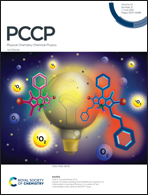Effect of Bjerrum pairs on the electrostatic properties of an electrolyte solution near charged surfaces: a mean-field approach†
Abstract
In this paper, we investigate the consequences of ion association, coupled with the considerations of finite size effects and orientational ordering of Bjerrum pairs as well as ions and water molecules, on the electric double layer near charged surfaces. Based on the lattice statistical mechanics accounting for finite sizes and dipole moments of ions, Bjerrum pairs and solvent molecules, we consider the formation of Bjerrum pairs and derive the mathematical expressions for Bjerrum pair number density as well as cation/anion number density and water molecule number density. We reveal several significant phenomena. Firstly, it is shown that our approach naturally yields the equilibrium constant for dissociation–association equilibrium between Bjerrum pairs and ions. Secondly, at low surface charge densities, an increase in the bulk concentration of Bjerrum pairs enhances the permittivity and decreases the differential capacitance. Next, for the cases where Bjerrum pairs in an alcohol electrolyte solution have a high value of dipole moment, the Bjerrum pair number density increases with decreasing distance from the charged surface, and the differential capacitance and permittivity are high compared to those for the cases with lower values of Bjerrum-pair dipole moments. Finally, we show that the difference in the concentration and dipole moment of Bjerrum pairs can lead to some variation in osmotic pressure between two similarly charged surfaces.



 Please wait while we load your content...
Please wait while we load your content...